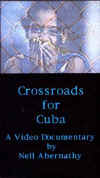Click here to Access Project
HOW
IT WORKS
Since
the fall of 1997, I have taught several courses on multimedia
production, including team teaching a course, called "Point
of View: constructing History" with a history teacher. Students
were required to produce a 10 minute documentary on an
historical period or event using an oral interview with
a family member or older friend who can speak from direct
experience. They
must also use video footage from other sources, documentaries,
popular movies, old family films, etc., as well as a
voice over narration and music in order to construct
a video which will contain their own point of view. They
learn about how editorial choices effect content and
what you don't say can be as significant as what you
do say. They
also learn about how much time and thought go into producing
a documentary. for
example, one student interviewed her grandmother who
was a Holocaust
survivor and intercut documentary footage and family
photos. Another student interviewed her father who was a television
producer during the Nixon resignation and incorporated
an interview with him along with documentary footage
as well as clips from feature films.
Another
student did her video on
the Cuban embargo and its history from the Bay of Pigs. She
interviewed her sister, a reporter in Cuba at the time,
and incorporated historical footage, taped music and
audio, as well s still images and voice over to create
a powerful piece denouncing the efficacy of the on-going
embargo. She
had created her own piece of propaganda.
One
student interviewed her mother who was in high school,
living on a Naval base with her family in Hawaii during
World War II and talked to her about what life was like
without men. she
also discussed her experiences having male friends who
were drafted and never returned. The
student's video included family pictures and historical
footage, popular music and voice over narration to create
a very personal and unique aspect of life for women during
WWII.
Another
student became interested in the historical accuracy
of the Steven Spielberg film, "Amistad", and she did
research of her own. She
interviewed people in the industry as well as an historian
and intercut their versions of the incidents and events
with Speilberg's film in creating her own analysis of
the way the film maker portrayed
or altered events for dramatic effect.
The
history teacher evaluated the historical content and
I did the media and technical aspects. I've
also worked with a physics teacher and his class in producing
short videos as final projects on physics topics. Currently
a small group of students are
working on a documentary about the founder of the school
to be shown at our Centenary celebration next year.
WHAT
YOU NEED
Camcorder,
scanners, Internet, digital editing software (such as
Media 100, EditDV, FinalCut Pro, etc.)
THE
STUDENTS
My
classes consist of 10th through 12th grade students. However
I have done video production and editing with as young
as third graders. Young
students are quite familiar with computers and take to
the computer editing process readily. Technical
involvement is more limited but possible.
OVERALL
The
best aspect of using video in education is that students
are highly motivated to use video, a format they are
familiar with, to explore and learn within the school
setting. Skills
developed include collaborative learning, technical procedures,
editorial decision making, organization skills, interpersonal
skills when doing an interview, and how effective media
can be as a learning tool and not just for entertainment.
Tips:
Pre-production
planning is the most important way to use class time
effectively and avoid frustration.
Forge
an alliance with a sympathetic teacher in another department. Two
are better then one when it comes to convincing administrators
of the value of video in education.
Be
prepared to put in the extra time and leg work video
production takes.
|

Duane Neil has
been teaching studio art for the past twenty-two years
and media education for the past thirteen. He
received his B.A. in Studio Art from St. John's University
in Collegeville, MN, and his Masters in Art Education at
the Rhode Island School of Design. He is currently the head of the Art Department at The Chapin
School in New York City where he teaches art and media
education in grades 4-12.
neil@chapin.edu
Subject: Arts,
Social Studies
Grades
3-12



|